Page 447 of 536
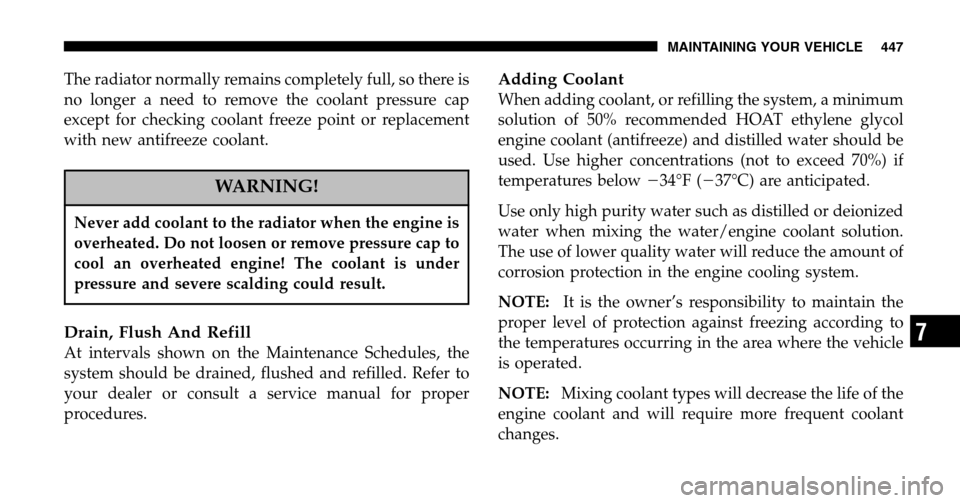
The radiator normally remains completely full, so there is
no longer a need to remove the coolant pressure cap
except for checking coolant freeze point or replacement
with new antifreeze coolant.
WARNING!
Never add coolant to the radiator when the engine is
overheated. Do not loosen or remove pressure cap to
cool an overheated engine! The coolant is under
pressure and severe scalding could result.
Drain, Flush And Refill
At intervals shown on the Maintenance Schedules, the
system should be drained, flushed and refilled. Refer to
your dealer or consult a service manual for proper
procedures.
Adding Coolant
When adding coolant, or refilling the system, a minimum
solution of 50% recommended HOAT ethylene glycol
engine coolant (antifreeze) and distilled water should be
used. Use higher concentrations (not to exceed 70%) if
temperatures below �34°F (�37°C) are anticipated.
Use only high purity water such as distilled or deionized
water when mixing the water/engine coolant solution.
The use of lower quality water will reduce the amount of
corrosion protection in the engine cooling system.
NOTE: It is the owner’s responsibility to maintain the
proper level of protection against freezing according to
the temperatures occurring in the area where the vehicle
is operated.
NOTE: Mixing coolant types will decrease the life of the
engine coolant and will require more frequent coolant
changes.
MAINTAINING YOUR VEHICLE 447
7
Page 448 of 536
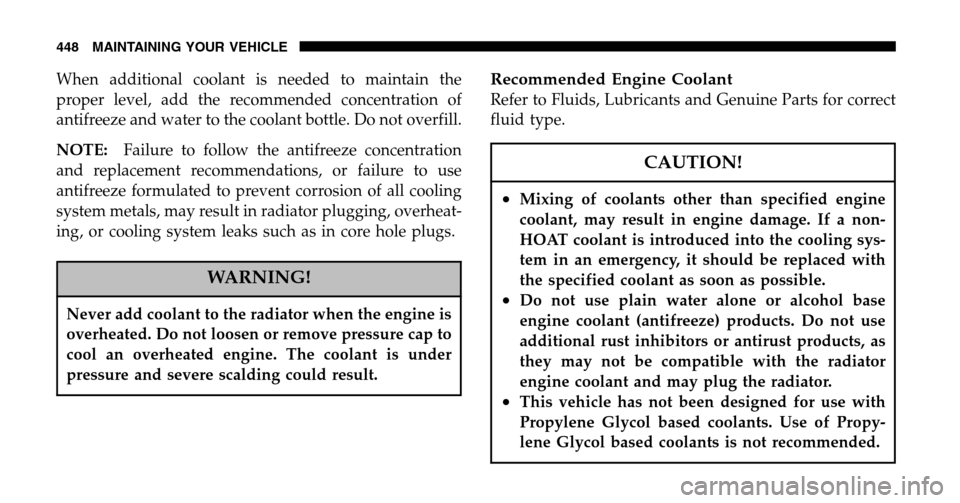
When additional coolant is needed to maintain the
proper level, add the recommended concentration of
antifreeze and water to the coolant bottle. Do not overfill.
NOTE: Failure to follow the antifreeze concentration
and replacement recommendations, or failure to use
antifreeze formulated to prevent corrosion of all cooling
system metals, may result in radiator plugging, overheat-
ing, or cooling system leaks such as in core hole plugs.
WARNING!
Never add coolant to the radiator when the engine is
overheated. Do not loosen or remove pressure cap to
cool an overheated engine. The coolant is under
pressure and severe scalding could result.
Recommended Engine Coolant
Refer to Fluids, Lubricants and Genuine Parts for correct
fluid type.
CAUTION!
•Mixing of coolants other than specified engine
coolant, may result in engine damage. If a non-
HOAT coolant is introduced into the cooling sys-
tem in an emergency, it should be replaced with
the specified coolant as soon as possible.
•Do not use plain water alone or alcohol base
engine coolant (antifreeze) products. Do not use
additional rust inhibitors or antirust products, as
they may not be compatible with the radiator
engine coolant and may plug the radiator.
•This vehicle has not been designed for use with
Propylene Glycol based coolants. Use of Propy-
lene Glycol based coolants is not recommended.
448 MAINTAINING YOUR VEHICLE
Page 449 of 536
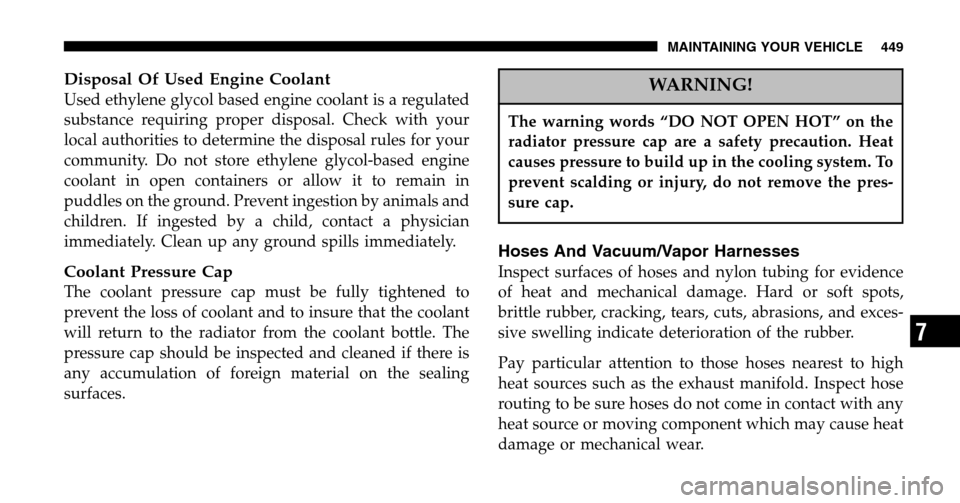
Disposal Of Used Engine Coolant
Used ethylene glycol based engine coolant is a regulated
substance requiring proper disposal. Check with your
local authorities to determine the disposal rules for your
community. Do not store ethylene glycol-based engine
coolant in open containers or allow it to remain in
puddles on the ground. Prevent ingestion by animals and
children. If ingested by a child, contact a physician
immediately. Clean up any ground spills immediately.
Coolant Pressure Cap
The coolant pressure cap must be fully tightened to
prevent the loss of coolant and to insure that the coolant
will return to the radiator from the coolant bottle. The
pressure cap should be inspected and cleaned if there is
any accumulation of foreign material on the sealing
surfaces.
WARNING!
The warning words “DO NOT OPEN HOT” on the
radiator pressure cap are a safety precaution. Heat
causes pressure to build up in the cooling system. To
prevent scalding or injury, do not remove the pres-
sure cap.
Hoses And Vacuum/Vapor Harnesses
Inspect surfaces of hoses and nylon tubing for evidence
of heat and mechanical damage. Hard or soft spots,
brittle rubber, cracking, tears, cuts, abrasions, and exces-
sive swelling indicate deterioration of the rubber.
Pay particular attention to those hoses nearest to high
heat sources such as the exhaust manifold. Inspect hose
routing to be sure hoses do not come in contact with any
heat source or moving component which may cause heat
damage or mechanical wear.
MAINTAINING YOUR VEHICLE 449
7
Page 484 of 536
U.S. Metric
Engine Oil (with filter) 3.7L Engine V-6, SAE 5W-30, API Certified 5.0 qts. 4.7L
4.7L Engine V-8, SAE 5W-30, API Certified 6.0 qts. 5.7L
5.7L Engine V-8, SAE 5W-20, API Certified 7.0 qts. 6.6L
Cooling System 3.7L (Mopar � Antifreeze/Coolant 5 Year/100,000 Mile
Formula) 17 qts. 16L
4.7L (Mopar � Antifreeze/Coolant 5 Year/100,000 Mile
Formula) 17 qts. 16L
5.7L (Mopar � Antifreeze/Coolant 5 Year/100,000 Mile
Formula) 18.7 qts. 17.7L
484 MAINTAINING YOUR VEHICLE
Page 485 of 536
FLUIDS, LUBRICANTS AND GENUINE PARTS
Engine
Component Fluids, Lubricants and Genuine Parts
Engine Coolant Mopar �Antifreeze/Coolant 5 Year/100,000 Mile Formula HOAT (Hybrid Or-
ganic Additive Technology) or equivalent.
3.7/4.7L Engine Oil Use SAE 5W-30, API Certified, meeting material standard MS-6395.
5.7L Engine Oil Use SAE 5W-20, API Certified, meeting material standard MS-6395.
Engine Oil Filter Mopar �Engine Oil Filter, P/N 5281090 or equivalent.
Spark Plugs Refer to the Vehicle Emission Control Information label in the engine com- partment.
Fuel Selection (all except 5.7L) 87 Octane, (R+M)/2 Method
Fuel Selection (5.7L) 89 Octane, (R+M)/2 Method, Mid-Grade Preferred (87 Octane acceptable)
MAINTAINING YOUR VEHICLE 485
7
Page 489 of 536

•Heavy Loading.
•Taxi, police, or delivery service (commercial service).
•Off-road or desert operation.
•If equipped for and operating with E-85 (ethanol)
fuel.
NOTE: IfANY of these apply to you then change your
engine oil every 3,000 miles (5 000 km) or 3 months,
whichever comes first and follow schedule “B” of the
� Maintenance Schedules �section of this manual.
NOTE: IfANY of these apply to you then flush and
replace your engine coolant every 102,000 miles (170 000
km) or 60 months, whichever comes first and follow
schedule “B” of the �Maintenance Schedules �section of
this manual.
NOTE: Most vehicles are operated under the conditions
listed for Schedule �B�. Second is Schedule
“A”. It is for vehicles that are not
operated under any of the conditions listed under Sched-
ule �B�.
Use the schedule that best describes your driving condi-
tions. Where time and mileage are listed, follow the
interval that occurs first.
NOTE: Under no circumstances should oil change in-
tervals exceed 6000 miles (10 000 km) or 6 months
whichever comes first.
CAUTION!
Failure to perform the required maintenance items
may result in damage to the vehicle.
MAINTENANCE SCHEDULES 489
8
M A I
N T
E
N A
N C E
S
C
H E
D
U L
E
S
Page 490 of 536
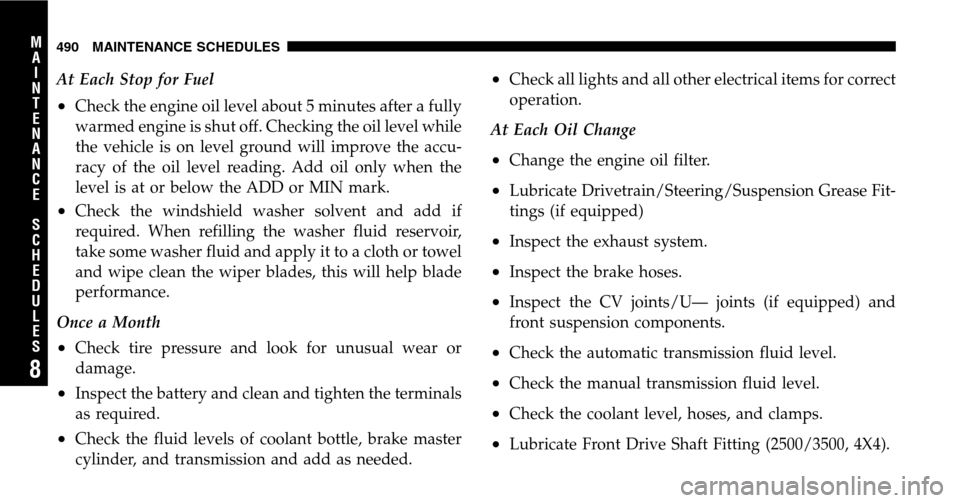
At Each Stop for Fuel
•Check the engine oil level about 5 minutes after a fully
warmed engine is shut off. Checking the oil level while
the vehicle is on level ground will improve the accu-
racy of the oil level reading. Add oil only when the
level is at or below the ADD or MIN mark.
•Check the windshield washer solvent and add if
required. When refilling the washer fluid reservoir,
take some washer fluid and apply it to a cloth or towel
and wipe clean the wiper blades, this will help blade
performance.
Once a Month
•Check tire pressure and look for unusual wear or
damage.
•Inspect the battery and clean and tighten the terminals
as required.
•Check the fluid levels of coolant bottle, brake master
cylinder, and transmission and add as needed.
•Check all lights and all other electrical items for correct
operation.
At Each Oil Change
•Change the engine oil filter.
•Lubricate Drivetrain/Steering/Suspension Grease Fit-
tings (if equipped)
•Inspect the exhaust system.
•Inspect the brake hoses.
•Inspect the CV joints/U— joints (if equipped) and
front suspension components.
•Check the automatic transmission fluid level.
•Check the manual transmission fluid level.
•Check the coolant level, hoses, and clamps.
•Lubricate Front Drive Shaft Fitting (2500/3500, 4X4).
490 MAINTENANCE SCHEDULES
8
M A I
N T
E
N A
N C E
S
C
H E
D
U L
E
S
Page 491 of 536
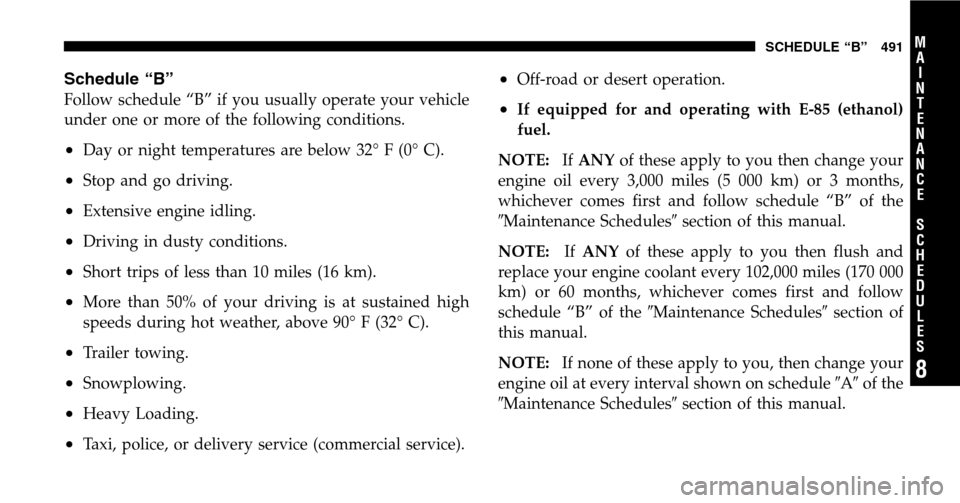
Schedule “B”
Follow schedule “B” if you usually operate your vehicle
under one or more of the following conditions.
•Day or night temperatures are below 32° F (0° C).
•Stop and go driving.
•Extensive engine idling.
•Driving in dusty conditions.
•Short trips of less than 10 miles (16 km).
•More than 50% of your driving is at sustained high
speeds during hot weather, above 90° F (32° C).
•Trailer towing.
•Snowplowing.
•Heavy Loading.
•Taxi, police, or delivery service (commercial service).
•Off-road or desert operation.
•If equipped for and operating with E-85 (ethanol)
fuel.
NOTE: IfANY of these apply to you then change your
engine oil every 3,000 miles (5 000 km) or 3 months,
whichever comes first and follow schedule “B” of the
� Maintenance Schedules �section of this manual.
NOTE: IfANY of these apply to you then flush and
replace your engine coolant every 102,000 miles (170 000
km) or 60 months, whichever comes first and follow
schedule “B” of the �Maintenance Schedules �section of
this manual.
NOTE: If none of these apply to you, then change your
engine oil at every interval shown on schedule �A�of the
� Maintenance Schedules �section of this manual.
SCHEDULE “B” 491
8
M
A I
N T
E
N A
N C E
S
C
H E
D
U L
E
S